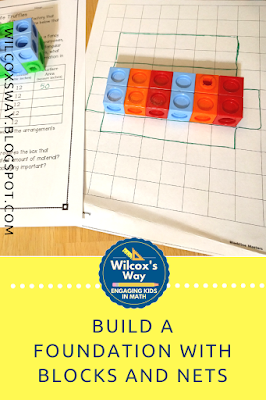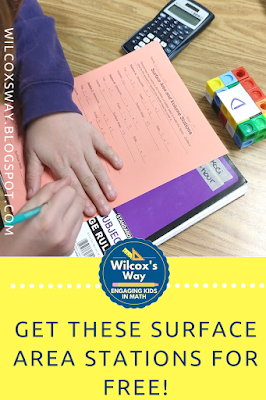- Activity 1: The first activity had students build arrangements of rectangular prisms using 12 interlocking cubes. Then they had to make a net for at least one of the rectangular prisms. I really think this was an important place to start. 6th grade standards expect students to learn about finding surface areas from nets, but I know that my students needed to review this foundational skill. This activity was a good place to start, but I also know that I didn't want to spend toooo much time having students build prisms. Let's face it, after a day, I was already tired of telling my kiddos to stop building everything else but rectangular prisms.
- Activity 2: I think the next activity that I did was the key to my kids understanding surface area and volume so well this year. I made up rectangular prisms of varying sizes and set them up at stations around the room. For each station, I had students list out the following information:
- Dimensions of the prism
- Dimensions of top
- Dimensions of front
- Dimensions of side
- Total volume (which I described as the number of cubes needed to build the figure)
- Total surface area (which I described as the number of stickers needed to cover the stickers)
This truly was class time well spent. Students really began to understand how surface area and volume were different and started to understand how to find the surface area. At the end of this day of stations, I showed students the formulas for volume and surface area of rectangular prisms, and they really made sense to them! Click here or the picture above to get a copy of these stations!
- Activity 3: The next activity that we did was a card sorting activity where students had to match 6 different types of cards: picture of the prism with lines, a picture of the prism without lines, dimensions, net of the figure, volume calculations, and surface area calculations. The card sorting activity, as well as the activity described in activity 1, are available in my Teacher's Pay Teachers store.
- At this point, my kids understand the concepts pretty well and they just needed PRACTICE! So we spent half of a class one day practicing, and that did wonders.
- Activity 4: Next, it was time to work on triangular prisms. I started by giving kids a worksheet of triangular prisms that were made on graph paper. I thought it was important to start this way because it gave students a chance to see how to make the prism and see the measurements. This only took about 15 minutes, so I was able to combine activities 4 and 5 into one day in class.
- Activity 5: Next, we moved on to nets of triangular prisms, but ones that listed measurements instead of showing the net on graph paper. Then we practiced drawing each of these figures as they would look when they were folded up. With each one, we talked about each of the sides of the net and where it would be on the 3-D version. I think this really helped my students be able to break down a 3-D figure into its parts. In fact, on my quiz, I saw some students redrawing the 3-D triangular prisms into nets.
At this point, I gave a quiz that had surface area and volume of rectangular prisms and surface area of triangular prisms.....and the kids TOTALLY rocked it! It was a quiz that was actually fun to grade because even my often struggling students were doing really well. Yay!!!




No comments:
Post a Comment